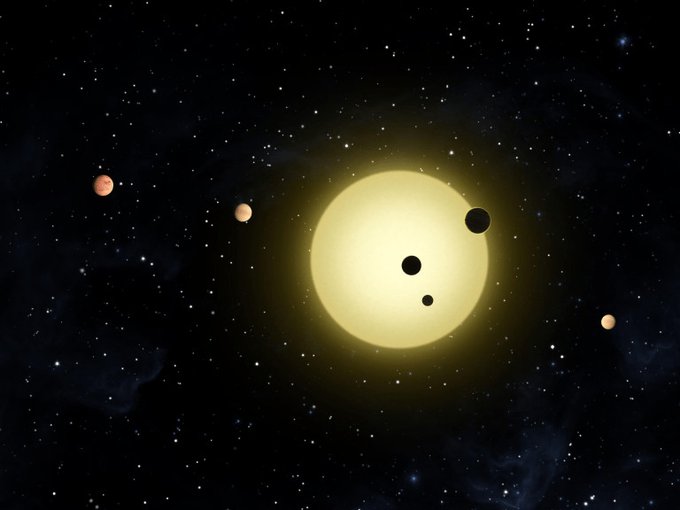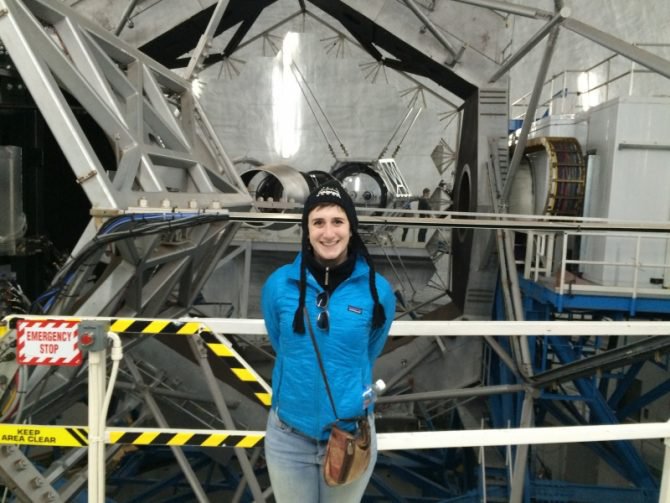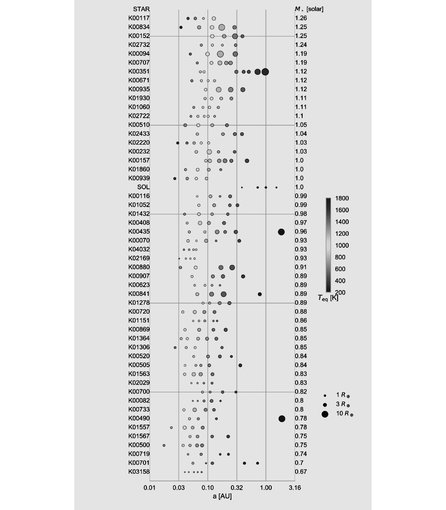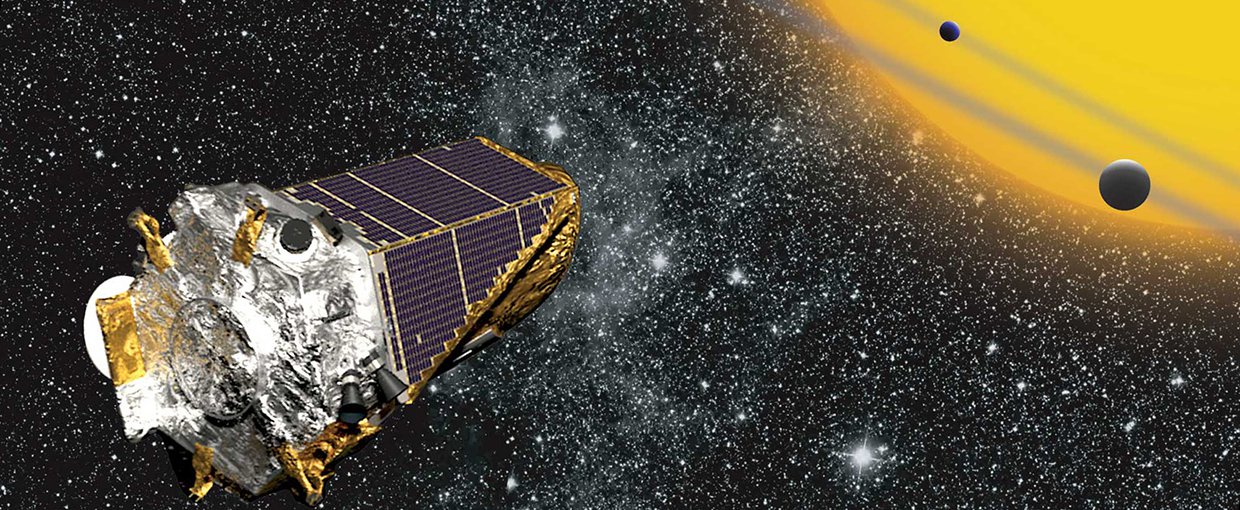
Before the discovery of the first exoplanet that orbits a star like ours, 51 Pegasi b, the assumption of solar system scientists was that others planetary systems that might exist were likely to be like ours. Small rocky planets in the inner solar system, big gas giants like Jupiter, Saturn and Neptune beyond and, back then, Pluto bringing up the rear
But 51 Peg b broke every solar system rule imaginable. It was a giant and hot Jupiter-size planet, and it was so close to its star that it orbited in a little over four days. Our Jupiter takes twelve years to complete an orbit.

The Kepler-11 system where the planets are all roughly the same size and their orbits spaced at roughly the same distances from each other. The the planets are, in the view of scientists involved with the study, “peas in a pod.”Image credit: NASA.
This was the “everything we knew about solar systems is wrong” period, and twenty years later thinking about the nature and logic of solar system architecture remains very much in flux.
But progress is being made, even if the results are sometimes quite confounding. The umbrella idea is no longer that solar, or planetary, systems are pretty much like ours, but rather that the galaxy is filled with a wild diversity of both planets and planetary systems.
Detecting and trying to understand planetary systems is today an important focus 0f exoplanet study, especially now that the Kepler Space Telescope mission has made clear that multi-planet systems are common.
As of early July, 632 multi planet systems have been detected and 2,841 stars are known to have at least one exoplanets. Many of those stars with a singular planet may well have others yet to be found.
An intriguing newcomer to the diversity story came recently from University of Montreal astronomer Lauren Weiss, who with colleagues expanded on and studied some collected Kepler data.
What she found has been deemed the “peas in a pod” addition to the solar system menagerie.

Lauren Weiss at the W.M Keck Observatory.Image credit: Marc Kaufman.
Weiss was working with the California-Kepler Survey, which included a team of scientists pouring over, elaborating on and looking for patterns in, among other things, solar system architectures.
Weiss is part of the California-Kepler Survey team, which used the Keck Observatory to obtain high-resolution spectra of 1305 stars hosting 2025 transiting planets originally discovered by Kepler.
From these spectra, they measured precise sizes of the stars and their planets, looking for patterns in, among other things, solar system architectures. They focused on 909 planets belonging to 355 multi-planet systems. By improving the measurements of the radii of the stars, Weiss said, they were able to recalculate the radii of all the planets.
So Weiss studied hundreds systems and did find a number of surprising, unexpected patterns.
In many systems, the planets were all roughly the same size as the planet in orbit next to them. (No tiny-Mars-to-gigantic-Jupiter transitions.) This kind of planetary architecture was not found everywhere but it was quite common — more common than random planet sizing would predict.
“The effect showed up with smaller planets and larger ones,” Weiss told me during last week’s University of Cambridge Exoplanets2 conference. “The planets in each system seemed to know about the sizes of the neighbors,” and for thus far unknown reasons maintained those similar sizes.
What’s more, Weiss and her colleagues found that the orbits of these “planets in a pod” were generally an equal distance apart in “multi” of three planets or more. In other words, the distance between the orbits of planet A and planet B was often the same distance as between the orbits of planet B and planet C.

The Kepler Space Telescope, operational since 2009.Image credit: NASA/JPL-Caltech/Space Science Institute.
So not only were many of the planets almost the same size, but they were in orbits spaced at distances from each other that were once again much more similar than a random distribution would predict. In the Astronomical Journal article where she and her colleagues described the phenomena, they also found a “wall” defining how close together the planets orbited.
The architecture of these systems, Weiss said, reflected the shapes and sizes of the protoplanetary in which they were formed. And it would appear that the planets had not been disrupted by larger planets that can dramatically change the structure of a solar system — as happened with Jupiter in our own.
But while those factors explain some of what was found, Weiss said other astrophysical dynamics needed to be at play as well to produce this common architecture. The stability of the system, for instance, would be compromised if the orbits were closer than that “wall,” as the gravitational pull of the planets would send them into orbits that would ultimately result in collisions.
The improved spectra of the Kepler planets were obtained from 2011 to 2015, and the targets are mostly located between 1,000 and 4,000 light-years away from Earth.

The architectures of California-Kepler study multi-planet systems with four planets or more. Each row corresponds to the planets around one and the circles represent the radii of planets in the system. Note how many have lines of planets that are roughly the same size.Image credit: Lauren Weiss, The Astronomical Journal.
Planetary system architecture was a significant topic at the Cambridge Exoplanets2 conference. While the detection of individual exoplanets remains important in the field, it is often treated as a precursor to the ultimate detection of systems with more planets.
The TRAPPIST-1 system, discovered in 2015 by a Belgian team, is probably the most studied and significant of those discovered so far.
The ultra-cool dwarf star hosts seven Earth-sized, temperate exoplanets in or near the “habitable zone.” As described by one of those responsible for the discovery, Brice-Olivier Demory of the Center for Space and Habitability University of Bern, the system “represents a unique setting to study the formation and evolution of terrestrial planets that formed in the same protoplanetary disk.”
The Trappist-1 architecture features not only the seven rocky planets, but also a resonance system whereby the planets orbits at paces directly related to the planets nearby them. In other words, one planet may make two orbits in exactly the time that it takes for the next planet to make three orbits.
All the Trappist-1 planets are in resonance to another system planet, though they are not all in resonance to each other.
The animation above from the NASA Ames Research Center shows the orbits of the Trappist-1 system. The planets pass so close to one another that gravitational interactions are significant, and to remain stable the orbital periods are nearly resonant. In the time the innermost planet completes eight orbits, the second, third, and fourth planets complete five, three, and two respectively.
The system is very flat and compact. All seven of TRAPPIST-1’s planets orbit much closer to their star than Mercury orbits the sun. Except for TRAPPIST-1b, they orbit farther than the Galilean moons — three of which are also in resonance around Jupiter.
The distance between the orbits of TRAPPIST-1b and TRAPPIST-1c is only 1.6 times the distance between the Earth and the Moon. A year on the closest planet passes in only 1.5 Earth days, while the seventh planet’s year passes in only 18.8 days.
Given the packed nature of the system, the planets have to be in particular orbits that keep them from colliding. But they also have to be in orbits that ensure that all or most of the planets aren’t on the same side of the star, creating a severe imbalance that would result in chaos.
“The Trappist-1 system has entered into a zone of stability,” Demory told me, also at the Exoplanets2 conference. “We think of it as a Darwinian effect — the system survives because of that stability created through the resonance. Without the stability, it would die. ”
He said the Trappist-1 planets were most likely formed away from their star and migrated inward. The system had rather a long time to form, between seven and eight billion years.
The nature of some of the systems now being discovered brings to mind that early reaction to the detection of 51 Pegasi b, the world’s first known exoplanet.
The prevailing consensus that extra-solar systems would likely be similar to ours was turned on its head by the giant planet’s closeness to its host star. For a time many astronomers thought that hot Jupiter planets would be found to be common.
But 20 years later they know that hot Jupiters — and the planetary architecture they create — are rather unusual, like the architecture of our own solar system.
With each new discovery of a planetary system, the understanding grows that while solar systems are governed by astrophysical forces, they nonetheless come in all sizes and shapes. Diversity is what binds them together.

